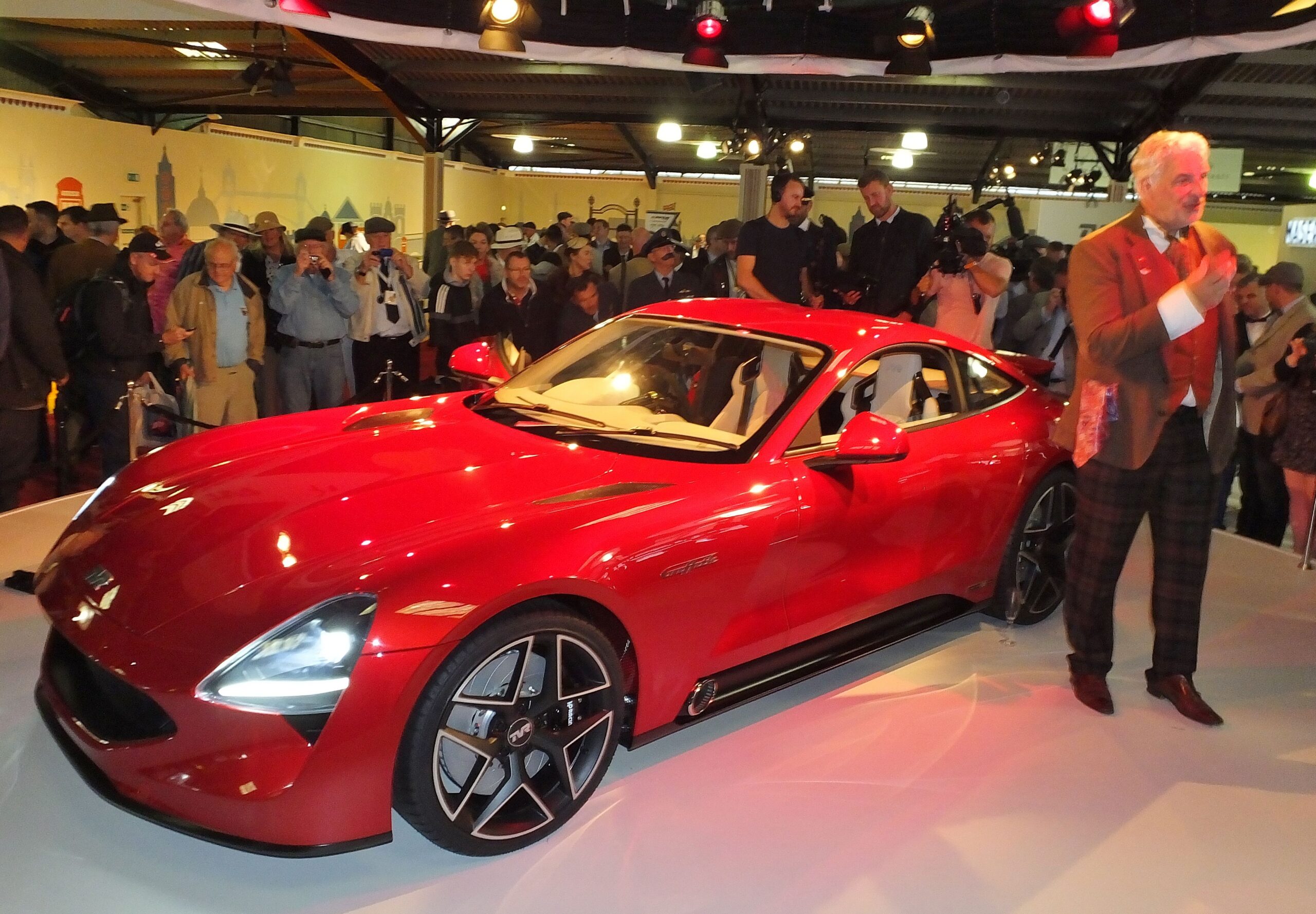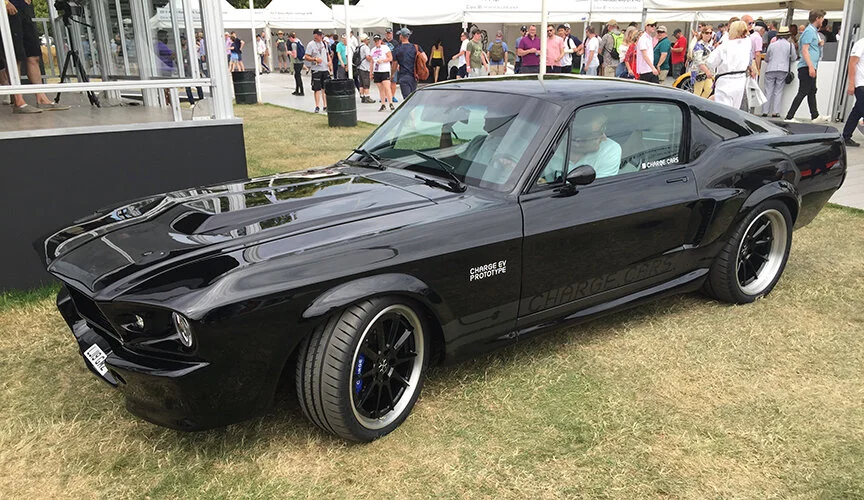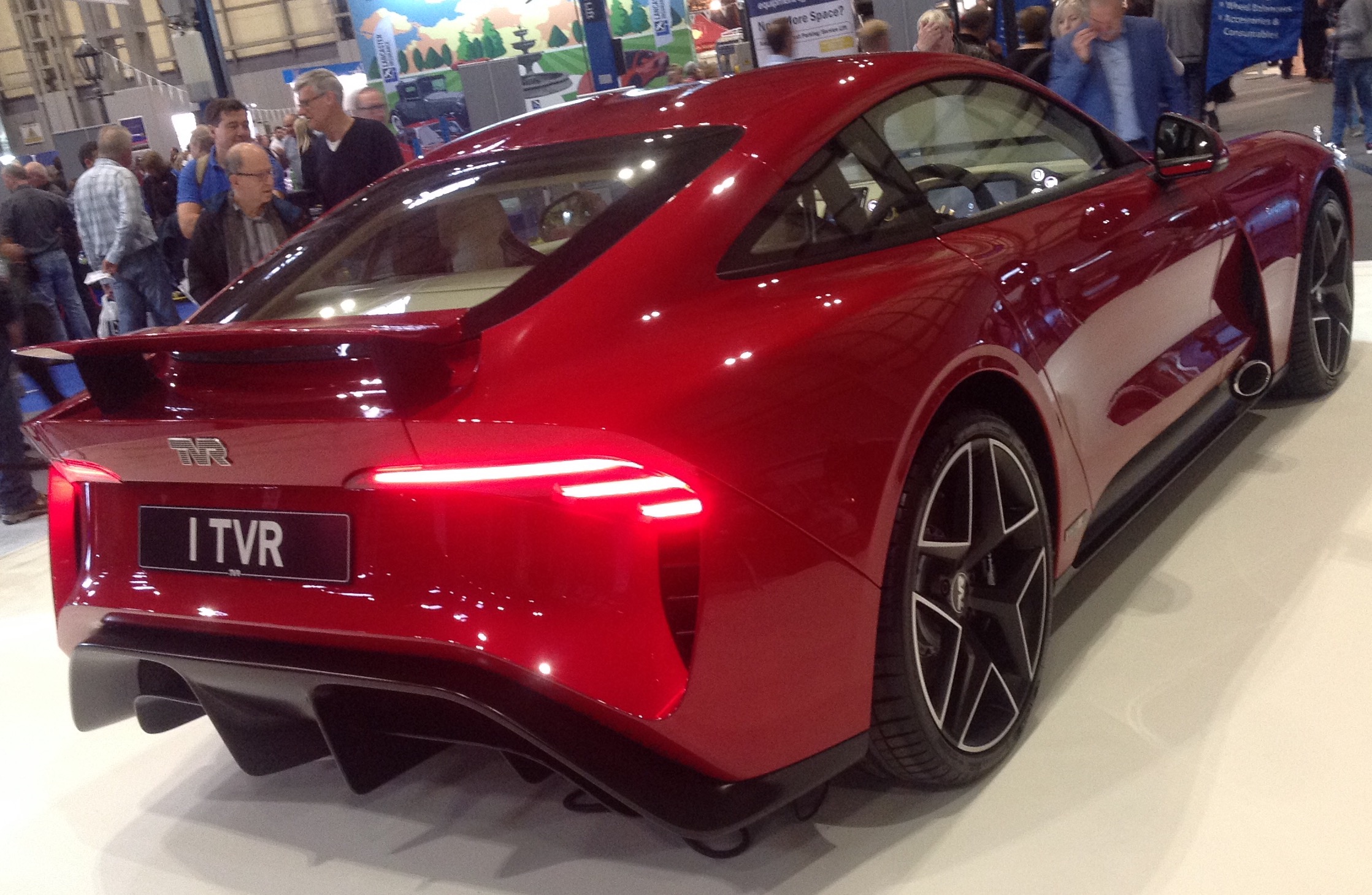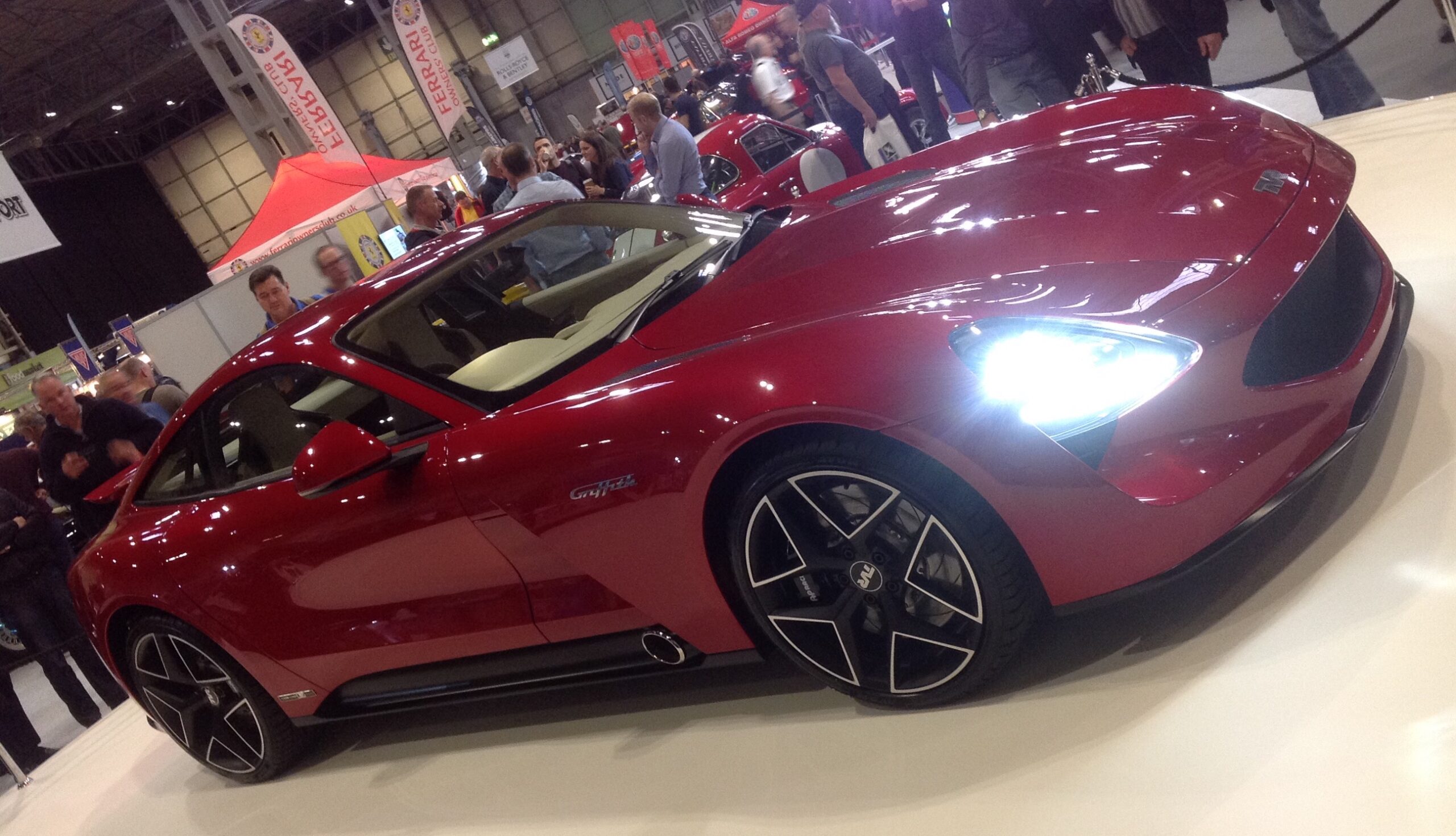There are certain headlines in the motoring world that make seasoned enthusiasts sit up a little straighter. Porsche unveils a new GT3. Caterham promises to keep the manual gearbox alive. Mazda insists the MX-5 will never die. And then there’s the other headline — the one that causes a different kind of alertness. A tiny rush of excitement, tinged with mild panic, followed by the involuntary whisper: “Oh God… not again.”
That headline appeared once more this week:
“Charge Holdings and TVR Automotive agree strategic framework for merger.”
You could almost hear thousands of TVR fans putting down their tea, staring into the middle distance and muttering, “How many lives does this company have?” Because while most carmakers move predictably through generations and facelifts, TVR has preferred to move through collapses, resurrections, mysterious silences, ambitious announcements, surprise rebirths, and periods of such profound inactivity that even the company’s own voicemail gave up.
But here we are. Again.
This is the part where a Hagerty-style journalist is supposed to lay out the sober facts of a corporate deal — board changes, ownership structures, future model strategies. But if you’ve followed TVR for more than five minutes, you’ll know there is nothing sober about this brand. TVR is equal parts passion, chaos and questionable decision-making. It’s the automotive equivalent of dating someone who keeps promising they’ve changed, only to later reveal they still haven’t fixed the roof and the alarm still goes off at 3 a.m.
And yet… we love them.
Because TVR built the kind of cars other companies were too sensible to bother with: wild, noisy, manually shifted missiles that leaked at the roof and occasionally caught fire but made you grin like a lunatic. Because TVR dared to build the Griffith, the Chimaera, the Cerbera and the Sagaris — cars with more personality in their headlights than most modern manufacturers manage in an entire marketing department.
So when the brand stirs again, even if it’s barely breathing, even if its accounts are flatter than an old Rover V8 lifter, enthusiasts feel something. TVR is British motoring’s greatest sleeping dragon. Or possibly its most persistent zombie. Either way, the damn thing keeps coming back.
And now someone new — a company called Charge Holdings — reckons they can bring the beast fully back to life.
Good luck to them. History suggests they’ll need every ounce of it.
What’s Actually Been Announced (The Sensible Bit)
Right, let’s get the boring-but-important part out of the way. While the press release was only marginally longer than a service reminder, here’s what it actually means in plain English:
1. Charge Holdings is taking over TVR, gradually but very firmly.
A “phased merger and acquisition process” is the polite legal way of saying: “We’re in charge now, but we’ll do it in stages so nobody panics.” TVR will become a subsidiary within Charge Holdings’ new small-volume automotive group.
2. Charge’s people are joining TVR’s board immediately.
This is how you know it’s serious. New brooms are not only sweeping, they’re already arguing over where to keep the broom.
3. The Griffith is officially the first car they intend to deliver.
Yes, that Griffith — the one unveiled in 2017 with a Cosworth-tuned Ford V8 and a Gordon Murray-designed iStream chassis. The plan, apparently, is to “refresh” it, which hopefully means “finish it” and not “add more carbon fibre and another delay.”
4. Electric TVRs will come later.
Charge Holdings describes itself as an EV/tech-forward group. The Griffith is the internal-combustion swansong. After that, we’re talking batteries and motors — though TVR insists the brand’s spirit will remain intact. (We will return to this… with questions.)
5. More details will arrive in early 2026.
Because of course they will. Announcing something and then vaguely promising a future announcement is extremely on-brand for TVR.
So the headline version is this: TVR has a new owner with cash, ambition, engineering capability, and a deep enthusiasm for electric powertrains. They say they can finish the Griffith, build new sports cars, and keep the TVR identity alive.
If all of this sounds plausible, optimistic, and strangely familiar… trust your instincts. This is TVR. Optimism and déjà vu are usually sold as a set.
Previously On The TVR Show
To understand why this announcement has caused a mixture of hope and acid reflux across Britain, you need to appreciate where TVR has been for the past two decades — which is to say, everywhere except in a functioning production facility.

Photo: Colin Haycock
Let’s recap the highlights reel:
2004–2006 — The Smolenski Years
A young Russian millionaire buys TVR on a whim, makes bold statements, moves tooling to a mysterious factory abroad, then discovers building low-volume sports cars is harder than it looks. TVR collapses shortly after. Fans sigh heavily.
2013 — Enter Les Edgar
A gentleman, enthusiast and businessman buys the brand, promising a sensible revival based on modern methods and new partners. Everyone relaxes slightly. A new Griffith is teased.
2015–2017 — The Griffith Lives!
TVR announces a 200mph V8 super-sports car using Gordon Murray’s iStream chassis. It looks bloody brilliant. Deposits are taken. A Welsh factory is secured with government support. Enthusiasts celebrate. Some even open champagne.

2018–2022 — The Welsh Factory That Time Forgot
The Ebbw Vale site needs renovation. EU state-aid rules require tendering. Estimates grow. Deadlines slip. The car doesn’t appear. Rumours swirl. The champagne goes flat.
2022–2023 — Ensorcia Joins the Chat
A new investor promising EV technology partners with TVR. Suddenly, the Griffith is electric again. Or not. There will be three EVs. Or two. Or maybe none. Hard to say, really. Depositors ask for timelines. Timelines decline the offer.
2024 — Silence, a Thruxton “Brand Centre,” and Worrying Accounts
TVR unveils no cars but opens a brand centre instead. The 2024 accounts show essentially no cash. CEO steps down mid-2025. This is the part of the TV show where the dramatic music plays.
And then…
2025 — A New Hope (Again)
Charge Holdings arrives, stage left, offering structure, EV capability, engineering leadership, and an apparent desire to actually build something.
If you are a TVR fan, you now have two choices:
- Hope cautiously, like a person approaching a barn-find Griffith with suspiciously fresh MOT plates, or
- Roll your eyes and mutter “I’ll believe it when I see tyre smoke.” Meet The New Saviour: Charge Holdings (A Perfectly TVR-ish Match)
- TVR: Took deposits. Didn’t deliver cars. Collapsed.
- Charge Cars: Took deposits. Didn’t deliver cars. Collapsed.
- A Cosworth-breathed Ford 5.0-litre V8
- A Gordon Murray iStream chassis
- A claimed 200 mph top speed
- Rear-wheel drive, manual gearbox, proper dimensions
- Pricing around £90k for early depositors
- The TVR spirit reborn, but with engineering adulthood
If you were hoping TVR’s new partner would be a calm, cash-rich, immaculately organised industrial giant with a century of experience and a spare factory lying around, I regret to inform you that you have mistaken TVR for a brand that exists in the normal universe.
Instead, meet Charge Holdings — a name that feels both modern and faintly threatening, like a fintech that wants to sell you cryptocurrency shaped like a fox.
Charge Holdings did not appear from nowhere. It grew from Charge Cars, the firm behind the head-turning, fully electric 1967 Mustang continuation car. You probably saw it at Goodwood — a beautiful, zero-emissions fastback that promised 536 electric horsepower, 200 miles of range, and the kind of instant torque that would have made Steve McQueen reconsider a Bullitt remake.

It was a great idea. So great, in fact, that Charge Cars took deposits, made headlines, toured the show circuit… and then delivered precisely zero customer cars before entering administration.
Now, before we judge too harshly: lots of small-volume EV projects struggled in that period. The industry was chaotic, supply chains were broken, and batteries were more expensive than having a Rolls-Royce serviced in Monaco.
But the symmetry is hard to ignore:
In the world of romance, this would be the plot of a Netflix show. Two loveably flawed individuals, each with their own history of big promises and spectacular disappointments, finding each other at just the right moment. Perhaps they’re exactly what each other needs. Perhaps they’ll destroy one another spectacularly. You tune in because either option is entertaining.
Charge Cars was revived by a new investor group, restructured, moved operations to Silverstone, and expanded into a broader automotive holding company. That company — Charge Holdings — now claims to have the technology, the capital, and the leadership to finally get TVR moving.
And you know what? Despite the comedic parallels, they might actually have a shot.
Charge has EV expertise, design talent, and the modern engineering tools TVR never had. They’re small, nimble, ambitious — everything TVR needs if it ever wants to leave PowerPoint and enter production.
If this partnership succeeds, it will be the most TVR thing ever: a brand that refused to die, revived by a company that also refused to die, banding together like two underdogs in a pub car park deciding they’ve had enough of being punched by reality.
If it fails, well… also extremely TVR.
The Griffith: The Car That Refuses To Exist
It’s impossible to talk about modern TVR without talking about the car that has hovered over the brand like a friendly ghost since 2017: the new Griffith.
There has never been a sports car so simultaneously present and absent. It has been shown, photographed, displayed, polished, sat in, admired, reviewed statically, and occasionally pushed — but never, to public knowledge, driven under its own power in anger.
The promise was intoxicating:
It was everything enthusiasts wanted. A modern British muscle sports car, the sort of thing you’d buy if you wanted a 911 alternative but felt the Porsche lacked sufficient danger.
The Griffith Launch Edition — Specs We Still Love
Engine: 5.0L Ford V8, Cosworth-enhanced
Power: 500+ hp target
Top Speed: 200 mph
Chassis: iStream
Gearbox: Manual
Weight: 1,250–1,300 kg target
Deposits were taken. Order books filled. The first 500 Launch Edition cars were “sold out.”
And then… nothing.
The Welsh factory never came online. The timelines slipped. The EV pivot muddied the waters. Confusion, frustration, and radio silence followed. The Griffith became famous all over again — but this time as a symbol of eternal promise without delivery.
Which brings us to today.
Charge Holdings says, quite bluntly, that the Griffith is still the first car they intend to build. Not an EV. Not a concept. Not a digital render on a promisingly well-lit website.
No — a proper, internal-combustion V8 Griffith. A bit refreshed, apparently, though the word “refreshed” in TVR land may denote anything from “updated electronics” to “we’ve replaced the door seals with ones that actually work.”
But this presents a question:
Can the Griffith be built in 2026 without becoming a museum piece?
The design is nearly a decade old. Gordon Murray’s iStream patents and licensing would need re-evaluation. The supply chain has changed entirely. Emissions regulations are a moving target. And the price — once near £90k — will certainly be much higher now. Likely six figures. Perhaps deep into them.
And yet…
The car still looks fantastic. It still stirs something. And TVR still claims it will be built.
If Charge Holdings can get even one Griffith into a customer’s hands, driven, photographed, and not spontaneously combusting, it will be the most significant moment in TVR’s modern history.
Until then, it remains the British automotive equivalent of Bigfoot: often sighted, frequently talked about, never confirmed to actually run.

What Tvr Fans Actually Want
To understand why this merger matters, you must understand TVR fans — a group of people who would rather daily-drive a 450hp fibreglass hand grenade than buy something sensible with airbags.
TVR fans do not want perfection. They want passion. They want danger. They want theatre. And they especially want:
1. Simplicity
TVRs were never about cutting-edge tech. They were about a big lump of engine up front, a stick in the middle, and rear tyres that lived short but glorious lives.
2. Noise
If a new TVR doesn’t sound like a mythical beast clearing its throat, the fans will riot. Politely, but firmly.
3. Manual gearboxes
If the future electric TVRs come with simulated gearshifts, fans will grudgingly accept it — but only if the fake shifts are violent enough to spill tea.
4. Danger — but the fun kind
Not actual flaming-footwell danger (though historically, that was part of the charm).
They want a car that feels alive. A car that rewards skill and mildly punishes stupidity.
5. Soul
No other British brand has quite the same hooligan charisma. TVR fans don’t want a polite, polished, hermetically sealed EV pod. They want something that feels like it escaped from a workshop at 2 a.m., leaving a trail of sparks.
6. A future — any future
What fans want most, honestly, is for TVR to simply exist again.
To build a car.
To deliver a car.
To show up at Goodwood in something that moves under its own power.
To prove the Griffith wasn’t a decade-long hallucination.
If Charge Holdings understands this — if they can capture the chaos, the charm, and the courage of the old TVRs while building something that actually reaches customers — they may not just save the brand.
They may give it the one thing it hasn’t had in years:
Momentum.
Callout Box: What TVR Fans Secretly Fear
• Another decade of silence
• An over-sanitised, polite TVR
• A simulated EV soundtrack that sounds like a Hoover
• Deposit-holder limbo, Part II
Can Charge Actually Pull This Off?
So far, so entertaining. But now we arrive at the sensible question — the one that separates an enthusiast article from a fan-fiction forum post:
Can Charge Holdings actually revive TVR?
On paper, it’s not impossible. They have the ingredients that previous TVR resurrections lacked:
1. Modern engineering capability
Charge Cars’ EV Mustang didn’t reach customers, but the tech was real. Their motor, battery integration, digital architecture and platform development were well ahead of anything TVR ever had access to. A future electric TVR could use these tools properly — not as marketing ornaments.
2. A multi-brand strategy
A single low-volume sports car company is financially suicidal.
A group of low-volume sports car and EV projects sharing R&D, parts, supply chains and expertise?
That’s much less suicidal — bordering on sensible. In theory.
3. Silverstone base of operations
Admittedly, the old TVR factory in Blackpool had charm. But “charm” is not a measurable unit on a CAD workstation. Charge’s shift to Silverstone gives TVR something it hasn’t had since the early 2000s: a home surrounded by serious automotive engineering talent rather than a chip shop and a stiff sea breeze.
4. Leadership with skin in the game
Paul Abercrombie and the Charge team have something TVR hasn’t seen in decades: a management structure that exists in the present day. People who answer emails. People who attend meetings. People who theoretically know how to build cars in 2026 rather than 1996.
5. A pragmatic timeline
Details coming in 2026 sounds ridiculous at first — but it may actually be the first realistic timeline TVR has ever offered.
TVR traditionally used timelines based on the optimistic estimation technique known as “Let’s just say next year and hope nothing catches fire.”
But there are challenges impossible to ignore:
1. Money
Small-scale car manufacturing eats capital like a Cerbera eats clutches. Charge Holdings will need investment that makes previous TVR budgets look like pocket fluff.
2. Regulatory reality
The Griffith was conceived in another decade. Emissions rules, crash standards and EV incentives have all shifted. “Refreshing” the car could mean “entirely re-engineering it.”
3. Reputation
TVR’s name is both a blessing and a curse. People love it — but deposit holders remember the last decade a bit too well.
4. Producing a car is the test
Not a prototype.
Not a press release.
Not a rendering.
Not a “brand centre.”
A car. A functioning, deliverable, legally roadworthy car with a VIN and a number plate and a warranty that doesn’t read like a suicide note.
Nobody in the TVR orbit — not fans, not detractors, not journalists — will be convinced until they see one rolling under its own power, leaving honest-to-goodness tyre marks on British tarmac.
If Charge can do that, even just once, they’ll have achieved something no one has managed since the early 2000s:
They’ll have made TVR real again.

And that, in itself, would be a miracle.
Closing: The Brand That Refuses To Die
TVR is a contradiction masquerading as a car manufacturer.
It is a brand that has collapsed more times than anyone can count, yet refuses to vanish.
A company that has burned through owners, factories, plans, promises and spreadsheets like a V8 burns super unleaded.
A marque so notorious for chaos that even its most loyal fans greet good news with the resigned optimism of someone watching a toddler carrying a saucepan of boiling water.
And yet… the affection remains.
Because TVR represents something beautifully rare in the modern automotive world: a willingness to build cars that are emotional rather than logical. Loud instead of sensible. Analog in a digital age. Slightly reckless in a world of lane-keep assistance and six layers of drive modes labelled “Eco+”.
Every time TVR pops back into the news, people get excited not because they expect a perfectly executed business plan, but because they want the brand to succeed despite itself. They want the roar of a Griffith. They want the madness of a Tamora. They want the silhouette of a Sagaris in the morning light. They want the eccentricity that only a small British company, working too late in a draughty factory, could ever produce.
So now we have Charge Holdings — a company reborn, merging with the brand that refuses to stay buried. Two comeback stories, intertwining. Two underdogs taking another swing. Two sets of engineers trying to build something improbable.
Will it work?
It’s impossible to know.
But with TVR, impossibility has never been a disqualifier.
If Charge succeeds, we may finally see a new Griffith on the road — a real one, with a key, a clutch pedal, and a soul.
If Charge pushes further, we may get the first electric sports car that feels less like an appliance and more like controlled mischief.
If everything aligns perfectly, TVR might finally enter the modern era not as a ghost of its former self, but as the most unlikely survivor in British motoring.
And if it all goes wrong again?
Well… it would be very TVR, wouldn’t it?
The truth — the emotional core of all of this — is that people want TVR to succeed not because it’s sensible, but because it’s TVR. Because it stands for something raw and human in a world of software updates and subscription features.
So here we are once more, watching the brand stir, stretch, and attempt to rise from its latest resting place.
TVR has died, yes. Many times.
But it never stays dead.
And maybe — just maybe — this time it truly comes back to life.
